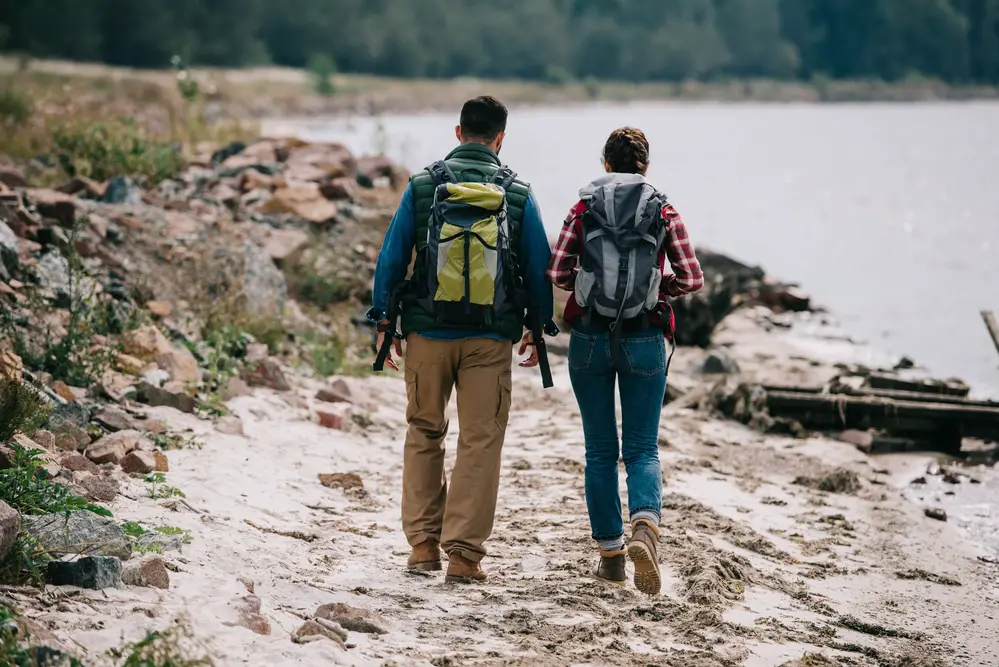There are so many great options to choose from when it comes to hiking that sometimes putting together hiking gear can be confusing. But here’s something that many inexperienced hikers often don’t think about- what colors should one wear while hiking and why is the choice of one’s hiking gear colors important?
The choice of hiking gear you eventually pack should depend on where you are hiking. Here are a few questions you should ask yourself before packing your clothes for a hike:
- What is the terrain type?
- How good is the visibility and the weather?
- Are you hiking solo or in a group?
- What are your fellow hikers likely to wear?
- Is it hunting season?
- Are you wearing layered clothes?
If you are going to hike in an area where visibility is low or if it’s hunting season, bright colors like yellow, orange and red are highly suggested. Muted shades like green, tan, brown and black are suggested if your aim is to camouflage and you are hiking in a group. In fact, experienced hikers also say that the chances of your getting bitten by insects reduces when you wear muted tones. Blue is best avoided as it attracts the most insects.
It is expected that hikers (yes, even beginners) be mindful of their surroundings and respectful to other hikers too. That also includes choosing shades that are not loud in appearance and which blend in to some extent with the surroundings. However, it is also important to plan ahead and that’s why carrying at least one brightly colored clothing or accessory (like a blanket) is important. Bright colors can help you to be easily spotted and can even save your life by getting you timely help!
How To Choose What To Wear On A Hike
It’s simple! You need to make a checklist of the essentials you need to pack before you set out on your hike. Here are the non-negotiable items of clothing that are an absolute must-
- Undergarments – Packing your favorite undergarment on a hike just won’t do. Pay attention to the material that is closest to your skin because better fabrics like polyester, nylon and merino wool will work wonders in wicking away moisture.
- T-shirts – Choose the length of the sleeves depending upon the season that you are hiking in. Choose material that will wick away moisture to the outer layers because that will ensure that you stay dry and comfortable.
- Pants – Hiking pants are the best choice to wear and the key is to go in for material that is quick drying. Pants that can be converted to shorts and worn knee-length are just what you need to brave any terrain.
- Jacket – The weather you are expected to enjoy will determine what kind of jacket you take along. If muted colors are more to your liking, I suggest packing a colorful jacket at least with you. Make sure it’s both wind and water proof as that will last you years.
- Socks – Cotton socks are an absolute no on a hike as they absorb sweat and will keep your feet wet, leading to blisters. Nylon is a good option to consider.
- Shoes –The type of weather you are expecting on the hike is the first factor to consider while packing footwear. Hiking boots are good for general weather (and are safer than sneakers) but a snowshoe is a better option if there’s bound to be rain.
- Hats – A good sturdy hat is a must irrespective of the weather you will be hiking in. I suggest that you pack a hat in a bright shade so that you can be spotted easily if you get lost. Buy a hat with a wide brim so that it protects you in winter and from nasty sunburn.
What Clothing Material Is Best
Sticking to the basics will go a long way in ensuring that you have an enjoyable hike. Fabrics like nylon and polyester are ideal for summer hiking because they help to wick moisture and hence keep one dry. This means that you won’t have to ensure chaffing or any other kind of skin irritation.
Since these fabrics are durable and lightweight, they will last you for years. Wool, especially, merino wool is great for helping in natural thermoregulation and it also has anti-microbial properties. Merino wool also does not lead to build up of body odor which can be a real issue if you plan to be on the road for a few days at a stretch.
Other Things To Consider Before Going On A Hike
- The hike is important so make sure that you have not overpacked for the trip. All that extra load can become cumbersome and slow down your natural pace.
- A hiker should be prepared for wearing layered clothing as that is a must to keep cool and warm in any sort of weather.
- Gloves are often skipped but it’s best to pack a pair even if you’re expecting sunny weather.
- Don’t even think of packing cotton socks on the hike- you’ll find that it will lead to more issues especially in terms of comfort.
- Carrying multiples of socks and undergarments is important as they can be rinsed, dried and then worn again.
- Don’t forget to carry at least one brightly colored clothing on you.

